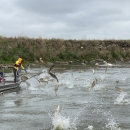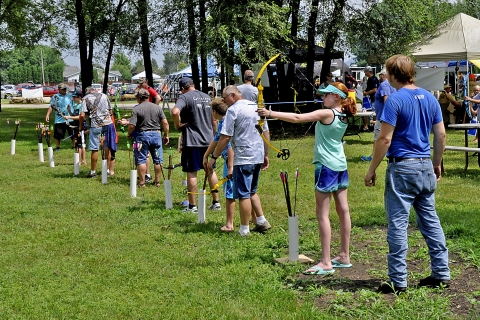About Us
The Whitney Genetics Laboratory:
- Supports control and management of invasive carp species by providing monitoring data
- Uses environmental DNA techniques to help prevent invasive carp from establishing sustainable populations in the Great Lakes
- Develops eDNA and next-generation sequencing tools to detect and monitor aquatic invasive species invasive species
An invasive species is any plant or animal that has spread or been introduced into a new area where they are, or could, cause harm to the environment, economy, or human, animal, or plant health. Their unwelcome presence can destroy ecosystems and cost millions of dollars.
Learn more about invasive species and threatened and endangered species - Works with numerous partners to complete the U.S. Fish and Wildlife Service mission
What We Do
At the Whitney Genetics Lab, we protect our aquatic habitats by playing an important part in early detection of invasive carp. Staff at the Midwest Fisheries Center and our partners collect and send thousands of eDNA samples to the Whitney Genetics Lab a year to be processed. eDNA is a useful tool used by managers to determine if more management action is needed to control invasive carp populations. We are expanding the use of eDNA to detect certain endangered species, and other invasive species invasive species
An invasive species is any plant or animal that has spread or been introduced into a new area where they are, or could, cause harm to the environment, economy, or human, animal, or plant health. Their unwelcome presence can destroy ecosystems and cost millions of dollars.
Learn more about invasive species in the region.
Our Organization
The Whitney Genetics Laboratory is housed within the Midwest Fisheries Center, which also includes the La Crosse Fish and Wildlife Conservation Office, La Crosse Fish Health Center, and administrative, GIS and outreach staff, as well as the Regional Watercraft Safety Coordinator.
The Midwest Fisheries Center is the region’s Fish Technology Center for U.S. Fish and Wildlife Service. Fish Technology Centers provide leadership in science-based management of trust aquatic resources through applied research and the development of new concepts, strategies and techniques to solve problems in aquatic resource conservation. Established in 2015, the Midwest Fisheries Center’s mission is: “Working in partnership, we provide leadership in science, technology and education for conservation of aquatic ecosystems emphasizing fisheries, aquatic invasive species invasive species
An invasive species is any plant or animal that has spread or been introduced into a new area where they are, or could, cause harm to the environment, economy, or human, animal, or plant health. Their unwelcome presence can destroy ecosystems and cost millions of dollars.
Learn more about invasive species , genetics and aquatic animal health for the benefit of the public”.
Our Species
The Whitney Genetics Lab works on detection of invasive species invasive species
An invasive species is any plant or animal that has spread or been introduced into a new area where they are, or could, cause harm to the environment, economy, or human, animal, or plant health. Their unwelcome presence can destroy ecosystems and cost millions of dollars.
Learn more about invasive species including the highly invasive bighead and silver carp, and the potentially damaging black and grass carp. In addition, the lab works on sensitive species, including the eastern hellbender ,Ozark cavefish, and Wood turtle.
Projects and Research
The Whitney Genetics Laboratory processes environmental DNA (eDNA) testing for early detection of invasive carp in multiple watersheds. Click here to find eDNA sample results.
Visit Us
Our lobby features informational displays describing local aquatic wildlife and our scientific research and conservation efforts, a Mississippi River mural and an aquarium of local native fish. The lobby is open to the public. Our laboratories and other work areas are not generally open for tours so we encourage visitors to email or call to pre-arrange a tour.
Get Involved
The Midwest Fisheries Center offers environmental education activities for community groups and schools. In addition, the center can lend fishing poles to local community groups. Each year, the center co-sponsors several events in the community. There are a variety of volunteer opportunities available in several different areas.






